Cuba’s has made remarkable progress toward the 17 Sustainable Development Goals far ahead of most nations and the 2030 target. But hostile US foreign policy based on outdated cold war ideology and covert agendas are making Cubans feel the pain. Why are we attempting to spoil one of the world’s best examples of high human development at low ecological footprints? Read on.
This week’s headlines about Cuba’s food and fuel shortages and frustrated citizens is heart wrenching. News channels and “experts” have several narratives, to either lay blame on Cuba or on the US.
The opening line of a “Voice of America” article went like this, “Down with communism, down with Díaz-Canel,” a Cuban woman chants defiantly.” A Reuters headline had a similar slant, “Amid blackouts and scarce food, Cuba protests rattle ‘cradle’ of the Revolution.” This slant is similar to the ongoing 60-year PSYOP (Phycological Operation) aimed at regime change by the CIA, promoted by corporate media.
On the left, Democracy Now! reports the Cuban President Miguel Díaz-Canel criticizing the U.S. saying “The most absurd thing is that they have applied a criminal blockade against us for more than 65 years. That is the absurdity.” In fact, the U.N. General Assembly has called upon the United States some 31 times to end its embargo against Cuba. The last vote was 187 to 2. The two opposing were the USA and Israel.
EMBARGO — The Longest Genocide in History
This “slant” is closer to reality. Anyone who believes in self-determination and non-intervention in the affairs within a nation, it seems clear the crippling embargo has to end. Cuba doesn’t threaten the US. On the other hand, the U.S. spends more on military than the next 9 nations combined, with covert and overt programs to overthrow Cuba, starting before the Bay of Pigs.
On my trips to Cuba, it hit home how harsh the embargo is and how resilient the Cuban population is in finding work-arounds. That said, the simplest things can take days. Daily necessities of food, fuel, medical supplies, tools, spare parts, are all scarce. A download of software is blocked, credit cards don’t work. The gig economy, banking, all blocked. Not by Cuba, but by ‘free’ America. I’d say, go see for yourself, but that’s restricted. Any nation that trades with Cuba is sanctioned.
The Trump-Biden policy turned the screws even tighter, further eliminating tourism and forbidding Americans to travel solo. This is what empires can do. Starve you, bomb you, coerce you to pledge allegiance to their free-market system, a system that robs the poor to enrich the wealthiest. All the while, they control the narrative. According to Oxfam, during the last two years “the top 1% have captured nearly twice as much new wealth as the rest of the world.” Most countries cave. Many Cubans have left, grow weary, but many haven’t, praying for the bully to the north to end the embargo and respect their sovereignty.
I bought a ticket in Cancun as it is illegal to travel for tourism. Cuba didn’t stamp my passport. Some might return from Cuba hating it. I LOVED it. Imperfect, yes, full of mistakes, yes, and still a dream lives on for a better way forward. The most common sentiment I heard from fellow travelers, Canadians and Europeans, is “I wanted to see Cuba before it’s ruined.” When asked what they mean, they scoff, “by capitalism.”
My trip in 2016 was to film, journalism being an accepted purpose. Flights were now possible from the US, but I had to agree to 17 activities which forbid having fun, tourism, giving a penny to the government. Approvals in hand, I didn’t expect trouble. “Fast and Furious” was being filmed in Havana, with cameras affixed to black helicopters following chase scenes through Old Havana. Just so happens, I was on a balcony, filming female revolutionaries as we laughed at the contradiction. Their budget: $250,000,000. Ours: $20,000. And, the U.S. state department seized our production funds, refusing to say why.
Meanwhile, the Cuban government approved every interview. I was worried when they sent along a producer. Turns out, he never interfered in over 20 interviews in 4 locations. He lugged camera gear, held lighting reflectors and got us to our locations. And he was fun, constantly joking about something.
Saving Walden’s World went to Cuba to uncover a story about two peasant struggles that captured the ire of the CIA – land reform and literacy. These two, led the way to eradicating poverty and achieving high scores in the sustainable development index. By 2015, Cuba was ranked as the nation most closely fulfilling three criteria––very high human development, low ecological impact and small families, putting Cuba in the running for the most sustainable society on earth.
The United Fruit Companies of the world preferred landless, illiterate peasants who won’t organize when mistreated. The hallmark of free market capitalism is to pay the lowest wage possible and charge the highest price the market will bear. Profits go to the owners of the capital, not the workers.
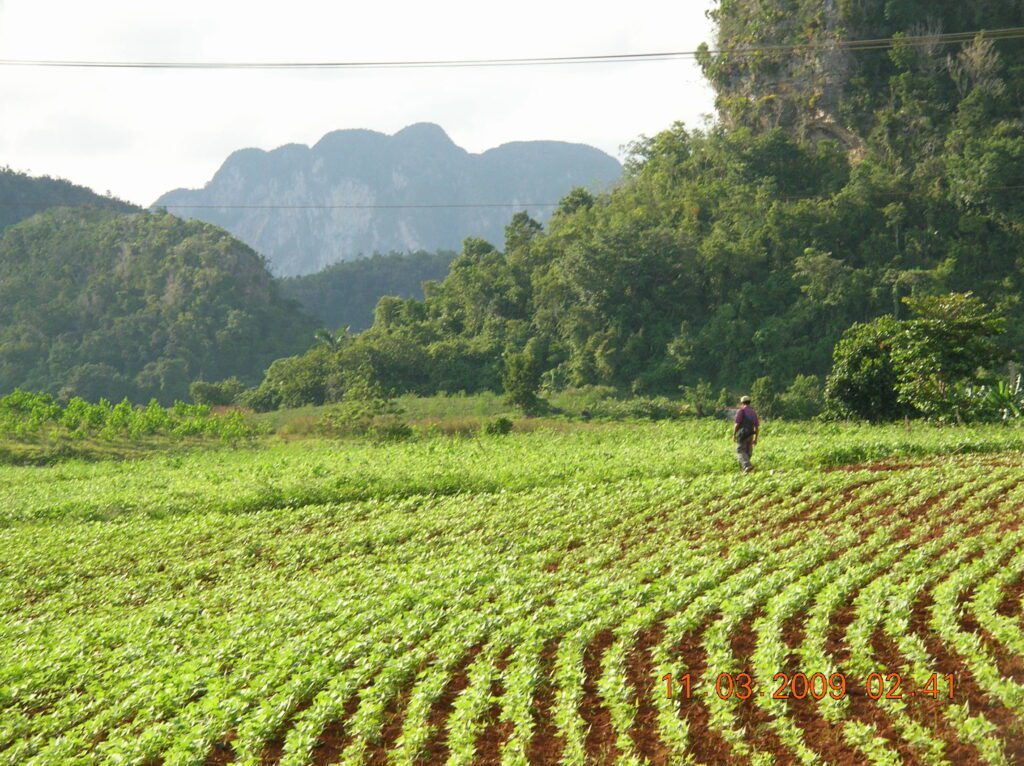
Sustainable Organic Farming in Vinales
Peasants getting land has been reason enough for the US to go to war, repeatedly. The Bay of Pigs invasion came after Cuba’s land reform where 250,000 farmers received title to land they had once worked. We interviewed Mavis Dora Alvarez, an agronomist who made this her life’s work. By contrast, the former enslaved in the US never received their 40 acres and a mule, eliminating any possibility of accumulating intergenerational wealth, poverty continuing till this day. Cuba attempted a different approach. Everyone we filmed had multiple college degrees and no automobile.
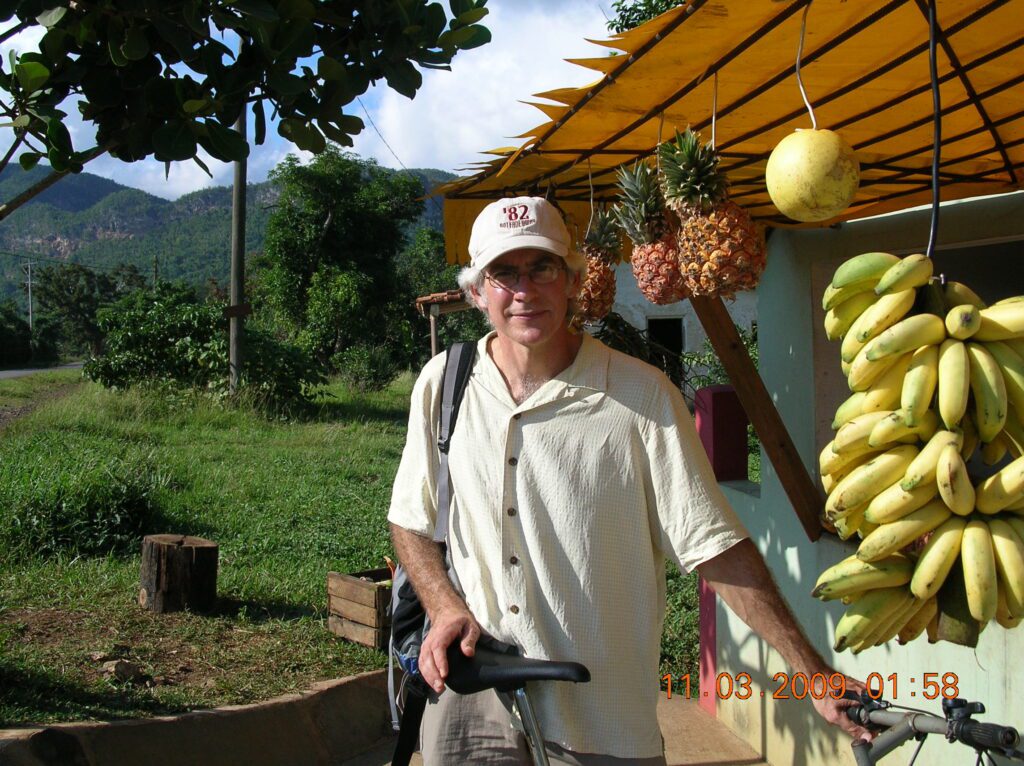

Jim Cycling Outside Vinales
In 2016 I met Luis and Ari, trying to find my way to an “International Congress” on José Martí, the Cuban icon of independence. People from dozens of nations attended. Ari introduced me to many of the movers and shakers in the community including Angela who directs the women’s studies program at the José Martí University.
Luis and Ari invited me to their flat in Sancti Spiritus. We arrive to musicians in the plaza playing Guaguanco, a subversive Afro Cuban rumba. The main street is a car-free pedestrian mall, with public art including bronze statues, one of an old man, who, legend goes, could quite accurately inform passersby of the time of day. From a balcony are views of laundry drying, the distant Sierra del Escambray mountains and the pulse of a lightly motorized population. Shops are lightly provisioned but friendly. Skirting the entire city are permaculture farms. Best of all, it’s not a tourist trap.
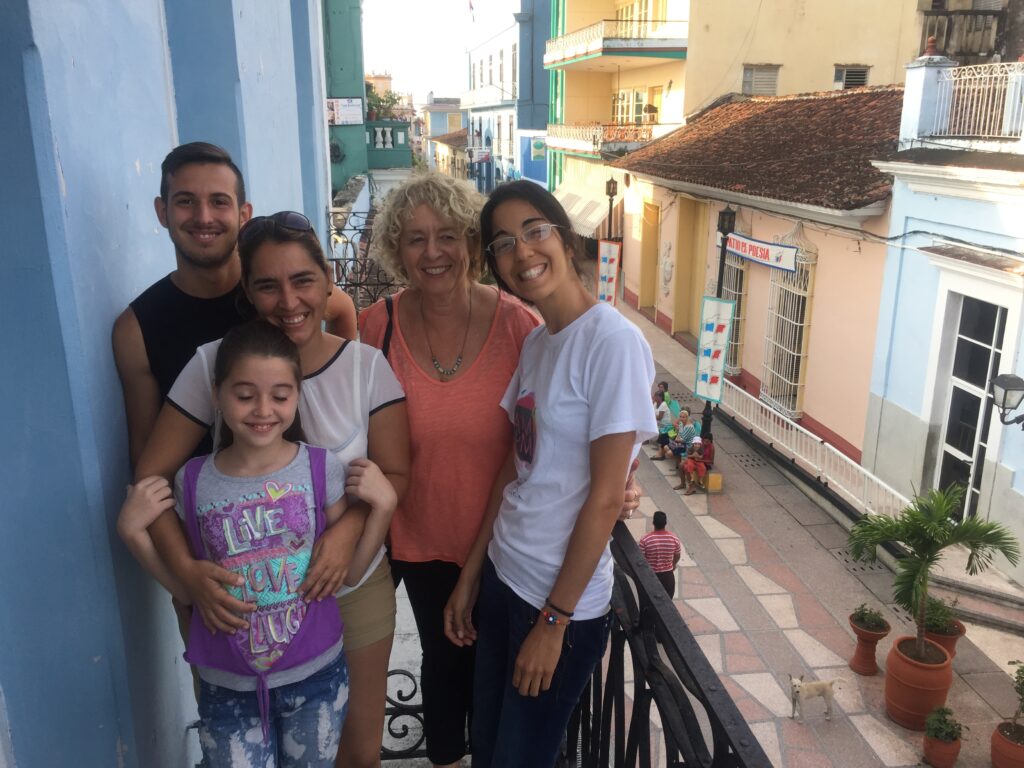

Luis, Ari, Ani, Deborah Shaffer and Susana Zamora Meriño
I’d been traveling by bus, in old cars and farm carts with my buddy Pedro, a Cuban filmmaker, in search of the stories for Saving Walden’s World. We’d been getting a taste of Cuban hospitality, which appear to dictate that your host’s normal sleeping arrangements are given to the guests. So tonight, despite protests, Pedro and I are sharing Luis’s and Ari’s bed, while they sleep in their daughter’s room.
As dinner time approaches, Ari and Luis are whispering across the room. They combine coins and Luis slips out the front door, returning quietly with two cans of vegetables. I pretend I didn’t see, frozen, guilt, embarrassment, sadness… for my country’s role in this family’s hardship.
I took orders for my future trip. Ari asked for printer ink, another friend, guitar strings, another art supplies, yet another, drill bits.
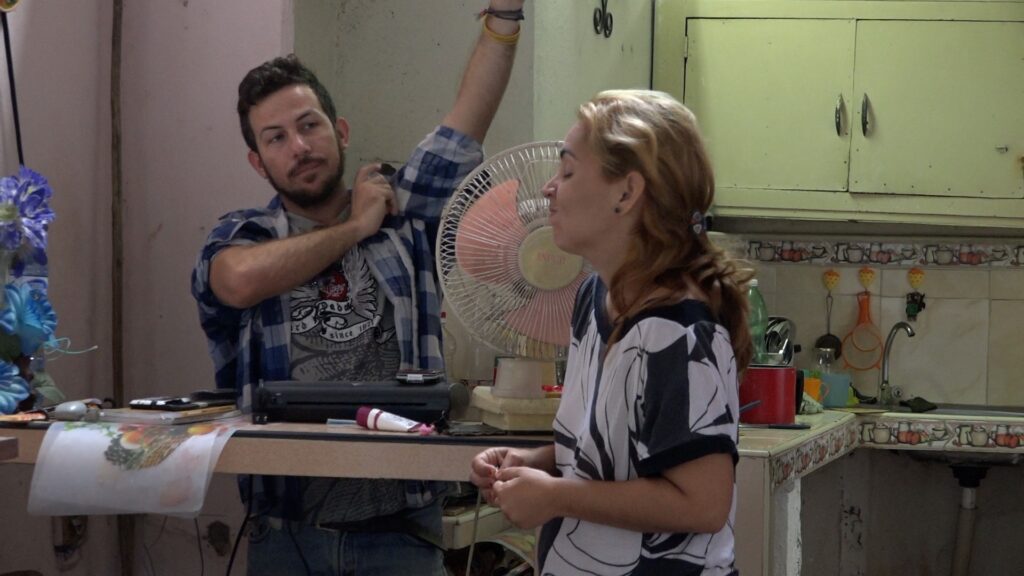

Pedro Martin Navarro and Ariadna Silva Arocha
This embargo has forced an artificial poverty on four generations of Cubans. Meanwhile, our prison population is the highest on earth on a per/capita basis. Cuba makes college free, while the US spends far more on incarceration. The same government that makes higher education, healthcare and child care free and sends doctors around the world, the US puts on a list of state sponsored terrorism. The island faces many challenges, yet, has infant mortality rates far below rates in the US, ranks higher in education and Cubans even live longer — with incomes a fraction of ours. In fact, Cuba has implemented many of the 17 Sustainable Development Goals far in advance of the 2030 target date.
In Havana I flag a sky-blue 50’s Chevy (almedrón) to visit the home of Norma Guillard Reina who was coming of age during the triumph of the revolution in 1959. On Norma’s second-story flat door is a bumper sticker “One Human Family.” Inside, Norma stalls at the photos on the refrigerator, a collage of an inspired life; her three college degrees, her one daughter, her great grandmother’s life as a Haitian slave with 11 children and no husband, her award for becoming the President of the Cuban Psychological Society, her traveling the US with the Catherine Murphy film “Maestra.” Growing up, Norma lived the oppression of Cuban society, but dreamed of a better day.
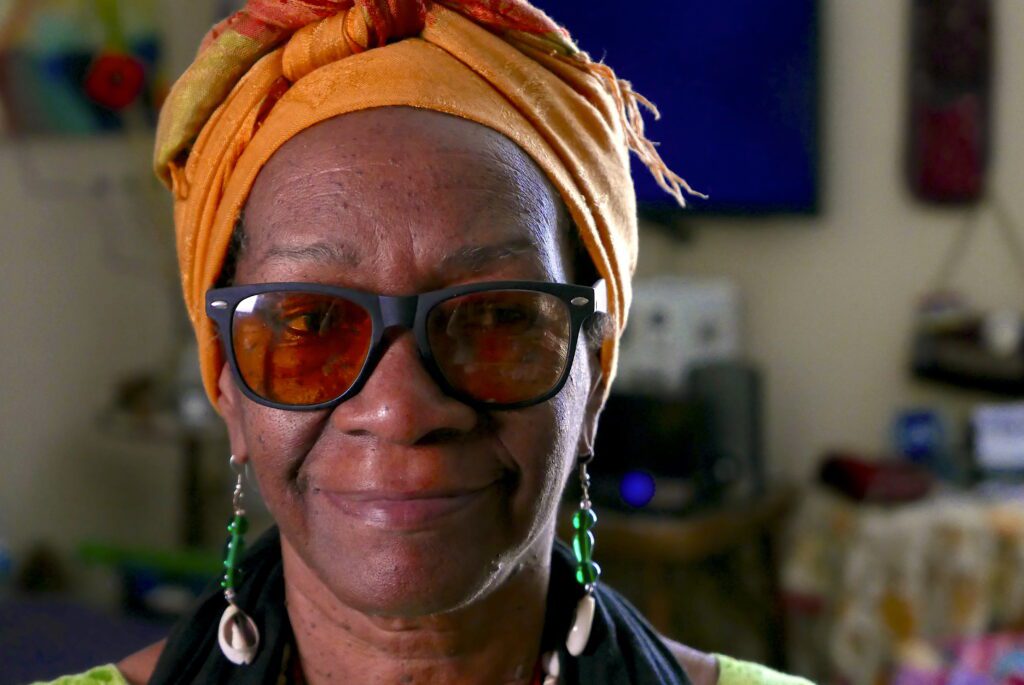

Norma Guillard Reina
Norma pulls out a pile of dog-eared photos from 1961. Standing tall in uniform with a backpack, ready to depart for the countryside, Norma and her sister answered the call of Cuba’s literacy campaign, along with 250,000 other youth volunteers. She says “the goal was to eradicate illiteracy in one year.” Norma explains, “my quince was coming up (turning 15) and my mom had made a beautiful dress, saved pesos for the photographer.” Under protest Norma agreed to wait for the second call to join the campaign. After her birthday, she was about to leave her barrio in Havana, when the US attacked Cuba at the Bay of Pigs, striking fear into her parents, but not into Norma.
She deployed and lived with a peasant family in their dirt floor shack picking coffee at sunrise and teaching literacy by candlelight–in a back room away from windows to avoid attack by US mercenaries. Norma exclaims, “The experience empowered my life. I come from a peasant family and all five of my siblings became professionals.” “Today I’m still the head of a research unit I named “Beings” because it’s dedicated to human beings and issues of racial discrimination, sexual diversity, HIV, AIDS, overcoming transphobia.”
Norma and Jim flag another almedrón and head to Vedado district to visit a friend, Mavis Dora Alvarez, also a literacy volunteer. Norma opens the metal gate and admires the fresh coat of paint on Mavis’s former “colonial” home as we walk up to the veranda full of plants. Norma explains, “Mavis’s mom was a servant here, now owns a part of it.” Mavis scolds our lateness, “cinco de la tarde!” then laughs and welcomes us. As a teen Mavis studied agronomy in Russia and later earned degrees in economics and gender studies, paid for by the Cuban government.
The two women sit on Mavis’s porch recounting their shared work toward gender equality, still in progress. From youth to elders their stories, photographs and historic footage set the context for the families visited and featured in Cuba. It is a story rarely told in the US, certainly not in the New York Times.
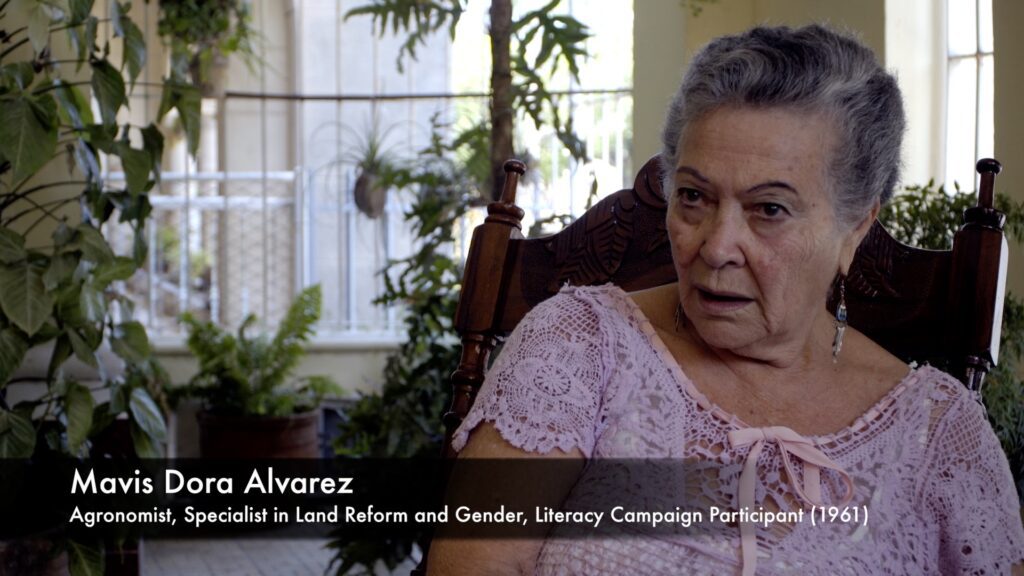

Mavis said, “When I started working with Agrarian Reform, 40 percent of Cuba’s rural population was illiterate… they would put an X or their finger prints on the land titles that I was bringing to them.” Mavis becomes animated, “Ownership of the farm went to the man, always. And I started to wonder: OK, but why always to the man and not the woman?”
Her voice gets soft, “the population of the Cuban countryside lived in dreadful poverty, because there was a great concentration of land in a very few hands and people… many people had no land. In other words,
Mavis toured the countryside explaining to sharecroppers that they now had legal title to the land that they had worked. She assumed leadership at the national level and spent her life working to improve the lives of women farmers with a specialty in gender issues. Sustainable development is at the heart of her life’s work.
To the film’s topic, she says “sustainability is brought about by an equitable system of land distribution. And ownership of that land must be in the hands of the person who produces… who works it, and not in the hands of someone who exploits it from afar.” Her work is exactly the rationale the US used to invade Cuba and elsewhere, killing literally millions of peasant farmers who were attempting freedom from empire.
Mavis continues, “I prepared myself militarily, because this is a country that’s always been threatened by … by our dear friends up north. I don’t say the American people; I’m talking about those interested in this country disappearing or this Revolution going away.”
She continues, “right now, 66 percent of technicians and professionals in Cuba are women. There’s no difference between rural and urban areas because education is free for all. There are schools everywhere, and also access to higher education… as people study more; schools are open, and they’re free…. life in the Cuban countryside today has nothing to do with what you’ll find out there in many regions of the world, including Latin America and Central America.” On a data sheet, Cuba is more similar to an advanced European social democracy than a low-income country.
Norma says, “I was working at the advertising agency and one of my concerns was precisely the image of the woman… to ensure that advertising in Cuba wouldn’t keep showing the woman’s image as an advertising object. When they sold the image of Cuba they sometimes put a girl… Mavis jumps in, “Usually showing her butt!” They laugh. Norma continues, “Yes, almost half naked, to sell beach tourism at that time.”
Norma and Mavis talk about their collaboration in forming “MAJIN” an organization that set out to transform society toward gender equality in the 90’s, leading workshops across Cuba, becoming specialists in communication via TV, radio and print media. Norma says, “When we wanted to say someone was intelligent we would say that person has “MAJIN,” meaning intelligence, fantasy, knowledge.” They said, “Mavis, what’s that madness about a workshop for women to talk about men and men about women? But it was unbelievable, and … and we kept doing it, all over Cuba!”
Literacy, land reform and gender equality… these women agree, were the most important steps toward sustainability and dignity. Norma recounts Fidel telling her, that women had created a revolution within a revolution. Here is a little taste of Saving Walden’s World in Cuba.
Are you ready to see change?
Saving Walden’s World looks at what is working today and how these solutions can shape a better tomorrow. Learn more and book your screening of Saving Walden’s World by visiting savingwaldensworld.org.
Copyright © 2024 Walden’s World Production – All rights Reserved | Designed by FerdaousWP